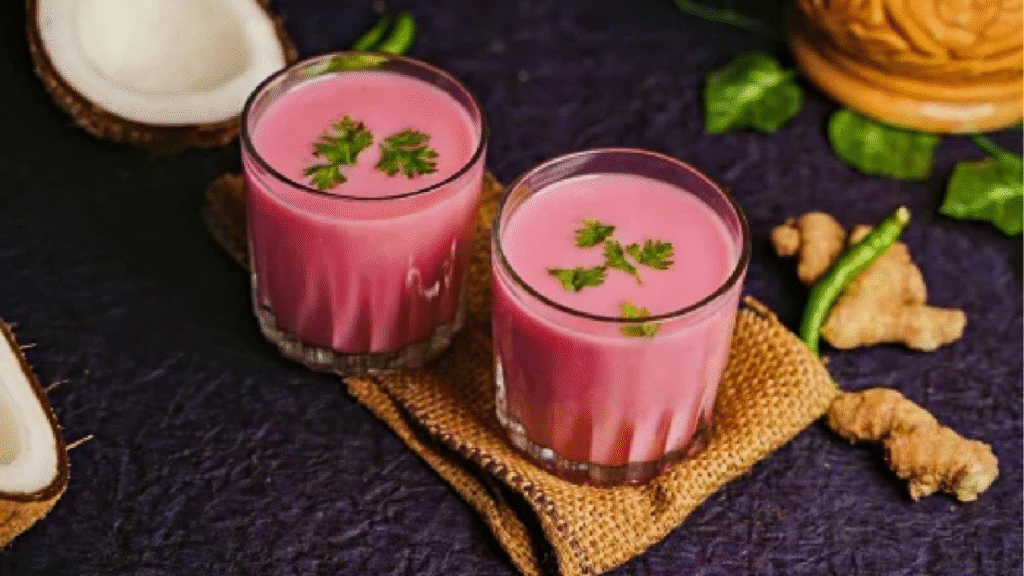A Taste of Coastal Cool
Solkadhi, the tangy and mildly spiced kokum curry, is more than just a summer cooler—it’s a treasured digestive tonic in Goan and Konkan households. With its soothing pink hue and a burst of flavor from dried kokum and rich coconut milk, this Solkadhi recipe is a staple alongside rice meals or enjoyed solo as a refreshing drink. Loved for its cooling and gut-friendly properties, this traditional beverage also complements spicy seafood and vegetable curries, making it a must-have during scorching Indian summers.
What Is Kokum and Why It’s Special
The magic of solkadhi lies in kokum—a souring fruit from the mangosteen family, native to India’s western coast. Once sun-dried, kokum rinds develop a deep purple-black color and release a natural pigment that gives solkadhi its signature mauve-pink tint.
Beyond its vivid appearance, kokum is celebrated for reducing body heat, aiding digestion, and balancing the pitta dosha as per Ayurveda. It’s especially common in the cuisines of Goa, Maharashtra, and coastal Karnataka, where it’s used in fish curries, juices, and traditional drinks like solkadhi.
Ingredients You’ll Need
- 12 dried kokum petals (aamsol)
- 1 cup water (for soaking kokum)
- 2 cups water (for dilution)
- 1 to 1.5 cups thick coconut milk (avoid lite versions)
- Salt to taste
Tempering (optional but recommended):
- 1.5 tablespoons neutral oil
- 1 teaspoon mustard seeds
- 1 teaspoon cumin seeds
- 1 sprig curry leaves
- 2 dry red chilies, broken
- 2–3 garlic cloves, crushed
- A pinch of asafoetida (hing)
- Finely chopped coriander for garnish
Step-by-Step Guide to Make Solkadhi
Step 1: Soak and Extract Kokum
- Rinse the kokum petals and soak them in 1 cup of water for at least 30 minutes.
- Once softened, crush the kokum with your fingers to release the sour juices.
- Strain the kokum water into a mixing bowl and press the petals well to extract maximum flavor.
Step 2: Blend with Coconut Milk
- Add 2 cups of plain water to the kokum extract.
- Stir in thick coconut milk and mix thoroughly. This will give the drink its rich, creamy base and tone down the sharp sourness of kokum.
- Add salt to taste and stir again. Set this aside.
Step 3: Prepare the Tempering (Tadka)
- In a small pan, heat oil on low flame.
- Add mustard seeds and let them crackle, followed by cumin seeds.
- Toss in curry leaves, broken red chilies, crushed garlic, and a pinch of asafoetida.
- Sauté for 30–40 seconds until the garlic turns slightly golden.
Step 4: Assemble and Serve
- Pour the tempering into the kokum-coconut milk mixture.
- Stir well and garnish with chopped coriander.
- Serve immediately or refrigerate for 1–2 hours for a chilled experience.
Tips to Perfect Your Solkadhi Recipe
- Always use thick coconut milk to prevent curdling. Fresh or canned versions work best.
- Press kokum thoroughly when straining—it holds a lot of the flavor and color.
- Refrigerate if not serving immediately, but consume within the same day for best taste and freshness.
- For a richer flavor, you can add a hint of green chili paste or ginger—but keep it subtle.
FAQs About Solkadhi
Q. Can I use kokum syrup instead of dried kokum?
Yes, but the flavor may differ slightly and be sweeter. Adjust water and omit extra salt or sugar accordingly.
Q. Is solkadhi good for digestion?
Absolutely. Kokum is known to aid digestion and reduce acidity, making this drink an excellent post-meal beverage.
Q. Can I skip the tempering step?
Yes. While tempering adds depth and aroma, solkadhi is just as delicious when kept simple.
Q. How long can I store solkadhi?
Ideally, solkadhi should be consumed the same day. If needed, refrigerate and use within 6–8 hours. Avoid storing overnight.
Traditional, Tasty, Therapeutic
This solkadhi recipe is more than a summer refreshment—it’s a blend of tradition, taste, and natural wellness. Whether served with a thali or sipped solo, kokum curry remains a beloved part of India’s coastal culinary identity. Cool your body, calm your stomach, and experience a burst of coastal flavor with every sip!


